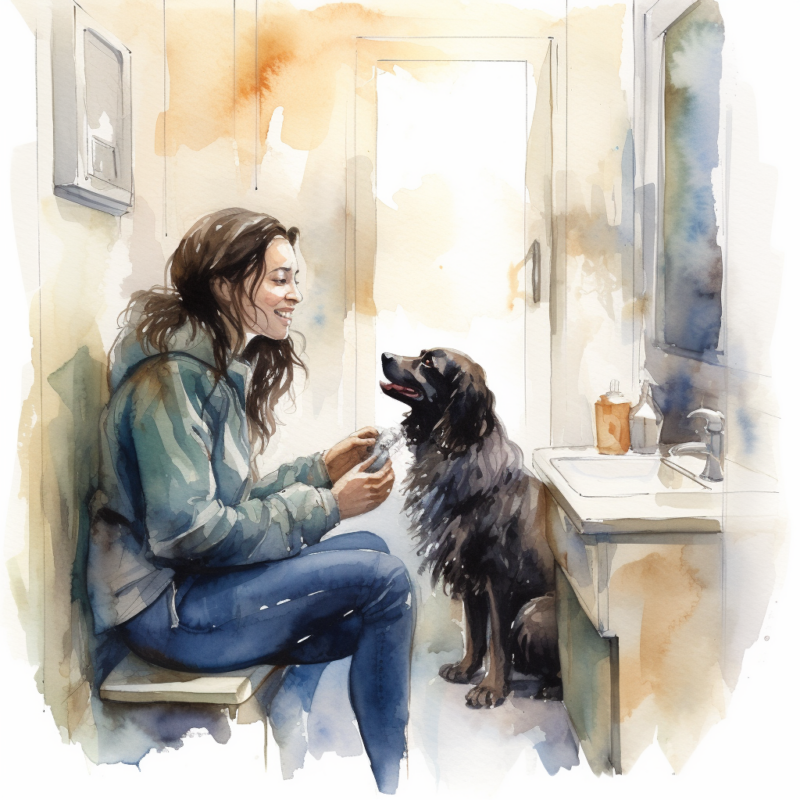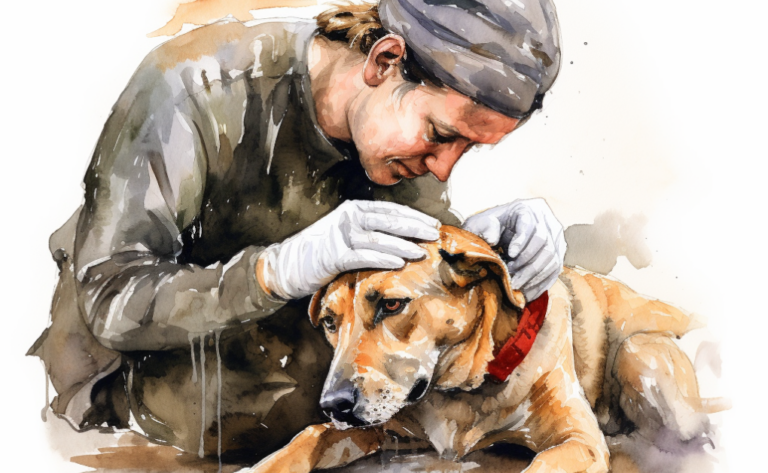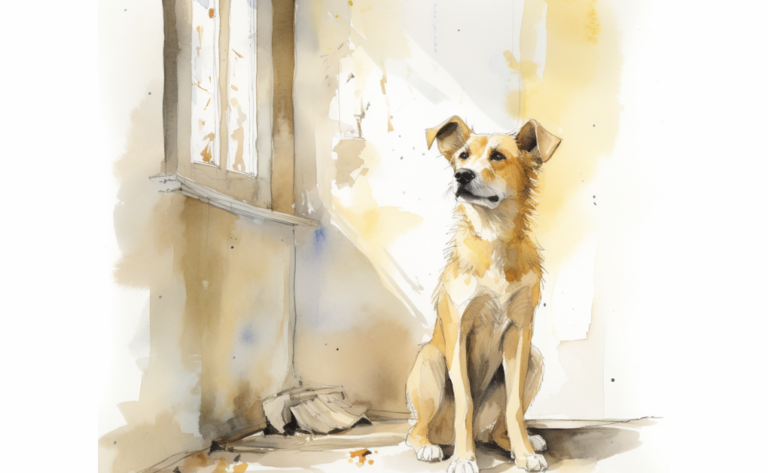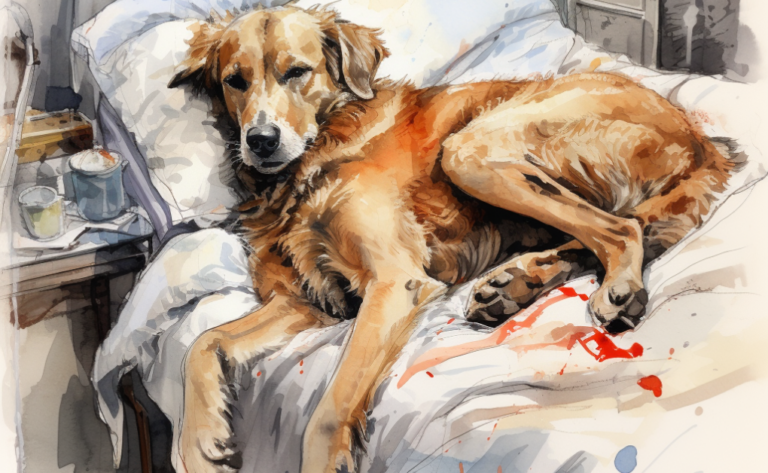Fractured Canine Teeth: Causes, Symptoms, and Treatment Explained
What is it?
How is it Treated?
Breed Predispositions
Greyhounds Chihuahuas Miniature Poodles Yorkshire Terriers Dachshunds Toy Poodles Cavalier King Charles Spaniels Jack Russell Terriers Maltese Shetland Sheepdogs
Introduction
During a lively game of fetch at the local dog park, Jack couldn’t help but admire his energetic German Shepherd, Thor, as he enthusiastically chased after the ball. As the sun began to set, they headed home, both tired but content. As Jack refilled Thor’s water bowl, he noticed a tiny piece of what appeared to be a tooth. Alarmed, he checked Thor’s mouth and discovered a fractured tooth, causing him concern for his beloved companion’s well-being.
Fractured teeth in dogs, also called tooth fracture, encompasses any form of breakage or damage to a dog’s tooth. Just as humans, dogs possess primary (or baby) and permanent sets of teeth, and fractures can occur in either. Such fractures can span a range of severity levels, from minor chipped tooth scenarios affecting only the tooth’s enamel to complicated crown fractures reaching the tooth’s pulp chamber – a sensitive area housing blood vessels and nerves.
A variety of activities and incidents can lead to fractured teeth in dogs. Examples include dogs chewing on hard objects such as bones, rocks, or metal; impacts resulting from playful roughhousing or accidents; or traumatic events like a fall or a forceful hit to the mouth. Teeth are common sites for dog injuries, and any type of tooth fracture, such as a slab fracture, can cause discomfort, pain, and further complications if not addressed promptly.
Potential complications can range from abscesses and infections to difficulties with eating and nutrition. Therefore, any suspected damage to a dog’s tooth must be examined by a veterinarian, who can assess the extent of the damage and determine the appropriate course of treatment and care.
Types and Causes of Tooth Fractures
Dental fractures in dogs vary in their types and the severity of their potential impacts on their overall health. They are commonly divided into several categories:
Enamel Fractures
Enamel fractures are the most straightforward type of dental fracture in dogs, only affecting the tooth’s outer layer – the enamel, which is covered by enamel. This hard, protective layer usually remains intact, and the underlying dentin or pulp cavity (the sensitive core of the tooth) is typically not exposed. Instead, trauma is often the root cause of these fractures, resulting from chewing on hard objects, a fall, or an impact.
Uncomplicated Crown Fractures
Uncomplicated crown fractures are a step up in severity and involve not just the enamel but also the layer beneath it, the dentin. However, even with this kind of fracture, the tooth’s pulp remains unexposed. The causes of these fractures often mirror those of enamel fractures, largely rooted in various forms of trauma.
Complicated Crown Fractures
When a fracture extends through the enamel and dentin and into the tooth’s pulp, it’s known as a complicated crown fracture. This type of fracture is quite severe and can lead to significant discomfort for the dog since the pulp cavity houses the tooth’s nerves and blood vessels. Trauma is the usual culprit behind complicated crown fractures.
Root Fractures
Root fractures are characterized by damage to the part of the tooth that resides below the gum line. These fractures can occur at any point along the root and may not be readily visible. Typically, they result from substantial trauma, leading to the tooth becoming loose or the root dying off.
Crown-Root Fractures
Involving both the crown (above the gum line) and the root (below the gum line) of the tooth, crown-root fractures are complex and often cause significant discomfort to the dog. Severe trauma, such as a blow to the face or chewing on extremely hard objects, are common causes.
Complete Fractures
Also known as avulsion fractures, complete fractures entail the complete displacement of the tooth from its socket. This severe type of fracture is often the result of considerable trauma, such as being hit by a car or experiencing a severe fall, and it typically affects the entire tooth, including the root. This fracture type may also occur due to root canal treatment if not performed with utmost care.
Whether it’s a molar or another type of tooth, it’s essential to note that a damaged tooth can lead to endodontic disease if not addressed promptly. Moreover, teeth don’t regenerate like other tissues, so intervention is necessary. Finally, the point at which a fracture occurred, such as a recently fractured tooth, may also impact the treatment approach. This is particularly important in younger dogs, which may still have developing teeth.


Symptoms of Fractured Canine Teeth
Recognizing a fractured tooth in your dog might be complex, as dogs are adept at concealing discomfort. However, certain symptoms might hint at the presence of a tooth fracture:
- Changes in Eating Habits
- Oral Discomfort
- Facial Swelling
- Bad Breath
- Bleeding From the Mouth
- Visible Tooth Damage
It’s crucial to remember that if you believe your dog has a fractured tooth, seeking veterinary care promptly is important. The pain stemming from a dental fracture can be intense, and leaving a fractured tooth untreated can result in serious complications such as infections.
Diagnosis of Fractured Teeth in Dogs
The process of diagnosing fractured teeth in dogs involves several steps:
Oral Examination
A thorough oral examination is the first step in diagnosing a fractured tooth in a dog. First, the veterinarian will inspect the inside of the dog’s mouth, looking for any visible signs of fractures, such as an uncomplicated crown fracture, broken or missing teeth, discoloration, or abnormal wear patterns. This includes closely examining the carnassial tooth, frequently fractured in dogs. Next, the dog may need to be sedated or anesthetized for a thorough examination, especially if a tooth root abscess is suspected or there’s evident pain or discomfort.
Palpation
During palpation, the vet uses touch to assess the condition of the dog’s teeth and gums. They will feel for any abnormalities, such as swelling or areas of pain, and evaluate the stability of the teeth. For example, loose teeth may indicate a complicated fracture involving the root or a crown-root fracture.
Dental Radiographs (Dental X-rays)
Dental radiographs, or dental X-rays, are crucial for diagnosing tooth fractures. These X-rays allow the vet to visualize the tooth’s pulp canal and internal structures, including the root and pulp tissue, which are not visible during a standard examination. The dental radiograph can reveal whether the fracture extends into the pulp or the tooth’s root, distinguishing an uncomplicated crown fracture from a complicated one. It can also help in identifying pulp necrosis or a tooth root abscess.
Vitality Testing
Sometimes, the veterinarian may perform a vitality test, especially if a complicated crown fracture is suspected. This test assesses the response of the pulp tissue inside of the tooth to stimuli to determine if the pulp is still alive. However, this can be less common in veterinary medicine than in human dentistry, as it requires specialized equipment and training, and interpretation can be challenging.
Each of these diagnostic methods contributes to a comprehensive understanding of the dog’s dental health, allows the tooth to be properly evaluated, and assists the vet in formulating an effective treatment plan for the fractured tooth. In addition, regular dental check-ups are essential for early detection and treatment of dental fractures, reducing the risk of more severe complications such as pulp necrosis.
Treatment Options for Fractured Teeth in Dogs

When a dog has broken a tooth, treatment will depend on the severity of the fracture, whether the pulp is exposed, and the overall oral and general health of the dog. A veterinarian or a veterinary dentist might suggest a variety of treatment options for fractured teeth, including:
Dental Fillings or Bonding
Dental bonding or fillings might be used for minor fractures without exposure to the pulp. This process involves the application of a bonded sealant to seal the fracture, prevent bacterial invasion, and restore the tooth’s function and appearance.
Vital Pulp Therapy or Root Canal Therapy
In cases where the tooth’s fracture exposes the pulp, the tooth may be treated with vital pulp therapy, also known as root canal therapy. This treatment involves the removal of inflamed or infected pulp, cleaning and disinfecting the pulp chamber and canal, then filling and sealing the canal. This treatment aims to save the tooth while eliminating pain or infection. Root canal treatment has a success rate of about 95 percent in dogs, making it a highly effective option.
Dental Crowns
After root canal therapy, a dental crown may be recommended, especially for fractured carnassial teeth or other significant chewing teeth. The crown offers added strength and protection to the tooth, preventing further fractures or damage.
Tooth Extraction or Oral Surgery
When the fractured tooth is severely damaged or infected, tooth extraction, a form of oral surgery, maybe the best treatment option. Despite being more invasive, it can often be the best way to alleviate pain and prevent potential complications such as abscess formation or systemic infection.
Pain Management and Antibiotics
Pain management is crucial in treating fractured teeth. Veterinarians often prescribe pain medications to keep the dog comfortable during healing. Additionally, antibiotics may be given if there’s a risk of infection or the development of periodontal disease.
Each treatment method has pros and cons; the most appropriate approach depends on the dog’s situation. However, all treatments aim to relieve pain, prevent infection, and maintain as much dental functionality as possible. Therefore, it’s important to consult with a veterinarian or a veterinary dental specialist to determine the best treatment for a dog with a fractured tooth.
Prevention of Fractured Teeth in Dogs
Pet owners can take several measures to prevent their dogs from suffering a broken tooth. Here are several strategies:
- Chew Toys Selection: Be mindful when picking a chew toy for your dog. Materials like animal bones, antlers, or hard nylon toys will likely fracture your dog’s teeth. Alternatively, opt for softer, dog-specific chew toys designed with your pet’s safety and dental care in mind.
- Dental Hygiene: Consistent dental maintenance, including tooth brushing, plays a key role in promoting overall oral health. It helps to prevent tooth decay and gum disease, both of which can compromise the strength of the teeth, making them more susceptible to fractures. Always use a toothpaste and brush designed for dogs, and if possible, aim to brush your dog’s teeth daily to keep their mouth pain-free.
- Routine Veterinary Check-Ups: Frequent oral health check-ups with your vet can help spot dental problems early before they escalate to more serious issues, such as teeth with complicated fractures. Vets can also offer professional teeth cleaning, which can serve to prevent oral health issues at the fracture site.
- Nutritional Diet: A well-balanced, nutrient-rich diet can bolster overall health, including dental health. There are specific types of dog food designed to help clean the teeth as your dog enjoys its meals.
- Training and Behavior Modification: Train your dog to avoid chewing on hard objects that are inappropriate, such as rocks or metal. This can prevent situations where a tooth is exposed to undue pressure, reducing the risk of fractures.
- Mouthguard: If your dog is involved in activities that might result in a blow to the mouth, like certain dog sports, consider a canine mouthguard. This could protect important teeth and prevent fractures.
Prevention of dental problems is always preferable to treating them, making regular preventative care a must for maintaining your dog’s dental health. Bear in mind in case a dental issue arises, there are multiple treatment options to ensure the well-being of your dog.
Frequently Asked Questions
Disclaimer: The information provided on this veterinary website is intended for general educational purposes only and should not be considered as a substitute for professional veterinary advice, diagnosis, or treatment. Always consult a licensed veterinarian for any concerns or questions regarding the health and well-being of your pet. This website does not claim to cover every possible situation or provide exhaustive knowledge on the subjects presented. The owners and contributors of this website are not responsible for any harm or loss that may result from the use or misuse of the information provided herein.







